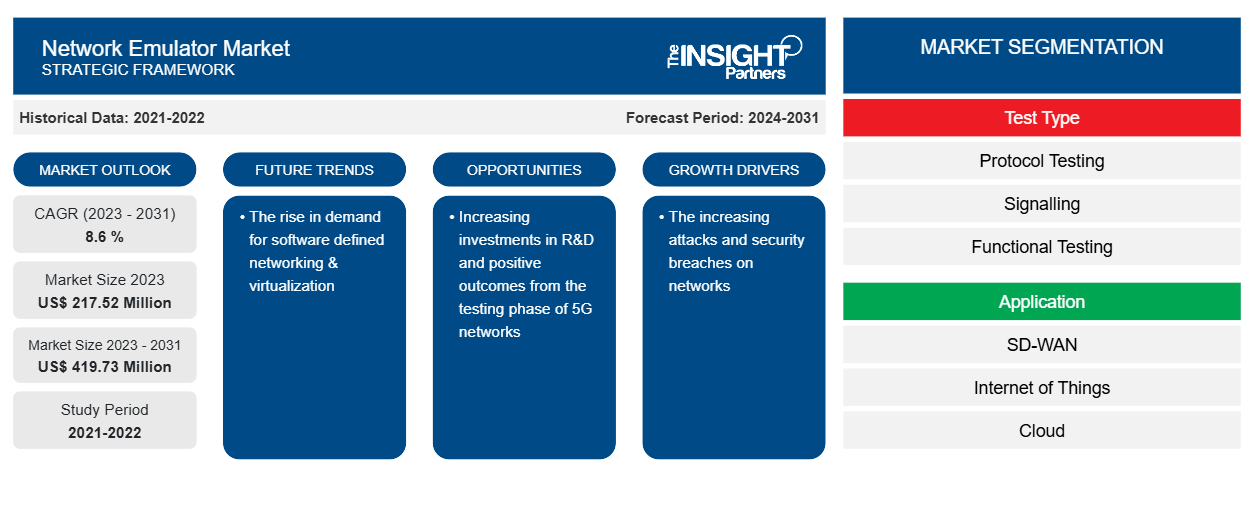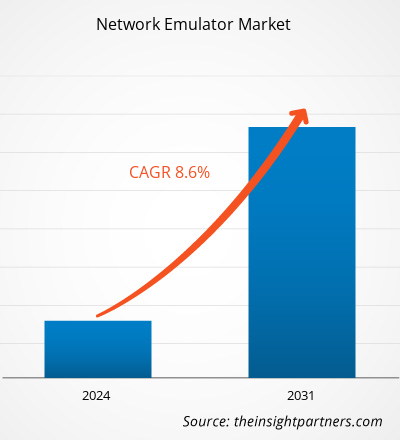The network emulator market size is projected to reach US$ 419.73 million by 2031 from US$ 217.52 million in 2023. The market is expected to register a CAGR of 8.6 % in 2023–2031. The rise in demand for software-defined networking & virtualization is likely to remain a key network emulator market trend.
Network Emulator Market Analysis
Due to widespread digitization, organizations are migrating more and more to cloud-based infrastructure, which is pushing them to use network emulator solutions to verify network performance and Quality of Service. The rise in cyberattacks is another factor propelling the market's growth. Before a network is finally deployed, network emulators test and validate its infrastructure, improve its performance, and minimize downtime. Telecom service providers are using robust network testing and emulation systems due to the increase in network traffic and outages, as well as the current expanding demand for 5G network services. They can test SG devices and base stations before the final deployment with the use of network emulation technologies. It is expected that this will be crucial in opening up new doors for the network emulator market.
Network Emulator Market Overview
Network emulation is the process of using virtual network tools, or network emulators, to test the performance of different applications in real-time. Service providers, application developers, and manufacturers utilize network emulation to test the reliability of a network application or product. Network emulators come equipped with routing, filtering, impairments, and modifiers as standard features. In contrast to network simulations, these emulations are mathematical representations of the channels, traffic, protocols, and network models that are applied to a network. Performance evaluation, change impact prediction, and technology selection optimization are the goals. Many common network characteristics are included in network emulator designs, such as packet duplication, available bandwidth, a certain level of packet loss, and round-trip time between network reordering packets.
Customize This Report To Suit Your Requirement
You will get customization on any report - free of charge - including parts of this report, or country-level analysis, Excel Data pack, as well as avail great offers and discounts for start-ups & universities
Network Emulator Market: Strategic Insights

-
Get Top Key Market Trends of this report.This FREE sample will include data analysis, ranging from market trends to estimates and forecasts.
Network Emulator Market Drivers and Opportunities
The increasing attacks and security breaches on networks
The growing prevalence of digital solutions and networked devices has led to a surge in cyberattacks and security breaches, underscoring the vital need for thorough network performance and security testing. Appropriate testing becomes crucial to preventing cybercrimes because of the possibility of product vulnerabilities. Network emulators are essential because they offer virtualized environments for extensive testing, guaranteeing the safety of devices and networks under a variety of circumstances. Organizations can troubleshoot, enhance performance, and create resilient networks with this capability. The importance of network emulators in strengthening security and defending against intrusions becomes a strong motivator for their wider use as cyber threats rise.
Increasing investments in R&D and positive outcomes from the testing phase of 5G networks
The need for mobile data and services is rising as 5G technology continues to advance. Industries will see a significant growth in machine-to-machine (M2M) communication, which will raise the need for fast and extensive network coverage. Additionally, this will present a significant global potential for network testing devices and emulators. It is anticipated that a number of significant nations, including the US, UK, Japan, South Korea, Germany, and China, will create and implement 5G wireless networks and equipment by 2024. Due to the huge increase in mobile users that would result from this, an infrastructure that can maintain connectivity even in the most adverse of circumstances would be needed. Networking solution investments are made in large quantities by communication service providers (CSPs) and networking enterprises. For instance, Huawei has made significant investments in the creation of 5G networks and gadgets. Thus, the Increasing investments in R&D and positive outcomes from the testing phase of 5G networks are anticipated to present new opportunities for the network emulator market players during the forecast period.
Network Emulator Market Report Segmentation Analysis
Key segments that contributed to the derivation of the network emulator market analysis are test type, application, and industry vertical.
- Based on the test type, the network emulator market is segmented into protocol testing, signalling, and functional testing. The protocol testing segment held a larger market share in 2023.
- By application, the market is segmented into SD-WAN, the Internet of Things, cloud, and others
- By industry vertical, the market is segmented into government and defense, retail & e-commerce, BFSI, healthcare, telecommunication, and others.
Network Emulator Market Share Analysis by Geography
The geographic scope of the network emulator market report is mainly divided into five regions: North America, Asia Pacific, Europe, Middle East & Africa, and South America/South & Central America. In terms of revenue, APAC accounted for the largest network emulator market share. Due to the increasing development and deployment of mobile 5G networks and applications, which are driving new investments in telecom, infrastructure, and cutting-edge applications like augmented reality and autonomous vehicles, APAC is predicted to experience the fastest growth in this market.
Network Emulator Market Regional InsightsThe regional trends and factors influencing the Network Emulator Market throughout the forecast period have been thoroughly explained by the analysts at The Insight Partners. This section also discusses Network Emulator Market segments and geography across North America, Europe, Asia Pacific, Middle East and Africa, and South and Central America.
Network Emulator Market Report Scope
| Report Attribute | Details |
|---|---|
| Market size in 2023 | US$ 217.52 Million |
| Market Size by 2031 | US$ 419.73 Million |
| Global CAGR (2023 - 2031) | 8.6 % |
| Historical Data | 2021-2022 |
| Forecast period | 2024-2031 |
| Segments Covered |
By Test Type
|
| Regions and Countries Covered |
North America
|
| Market leaders and key company profiles |
|
Network Emulator Market Players Density: Understanding Its Impact on Business Dynamics
The Network Emulator Market is growing rapidly, driven by increasing end-user demand due to factors such as evolving consumer preferences, technological advancements, and greater awareness of the product's benefits. As demand rises, businesses are expanding their offerings, innovating to meet consumer needs, and capitalizing on emerging trends, which further fuels market growth.

- Get the Network Emulator Market top key players overview
Network Emulator Market News and Recent Developments
The network emulator market is evaluated by gathering qualitative and quantitative data post primary and secondary research, which includes important corporate publications, association data, and databases. The following is a list of developments in the market for speech and language disorders and strategies:
- In April 2024, ALifecom announced the release of its Non-Terrestrial Networks IoT Platform. This platform is the industry’s first integrated solution embedding a channel emulator into ALifecom’s NE6000 network emulator to effectively simulate and test NTN communications within a small form factor, user-friendly, and cost-effective solution. (Source: ALifecom, Press Release)
- In May 2023, Gatehouse Satcom created a digital twin that offers a dynamic virtual emulation of Inmarsat’s physical satellite network, which looks and behaves identically to its real-world counterpart. (Source: Gatehouse Satcom, Press Release)
Network Emulator Market Report Coverage and Deliverables
The “Network Emulator Market Size and Forecast (2021–2031)” report provides a detailed analysis of the market covering below areas:
- Market size and forecast at global, regional, and country levels for all the key market segments covered under the scope
- Market dynamics such as drivers, restraints, and key opportunities
- Key future trends
- Detailed PEST/Porter’s Five Forces and SWOT analysis
- Global and regional market analysis covering key market trends, major players, regulations, and recent market developments
- Industry landscape and competition analysis covering market concentration, heat map analysis, prominent players, and recent developments
- Detailed company profiles
Frequently Asked Questions
What will be the market size of the global network emulator market by 2031?
Which are the key players holding the major market share of the global network emulator market?
What are the future trends of the global network emulator market?
What are the driving factors impacting the global network emulator market?
What is the estimated market size for the global network emulator market in 2023?
- Historical Analysis (2 Years), Base Year, Forecast (7 Years) with CAGR
- PEST and SWOT Analysis
- Market Size Value / Volume - Global, Regional, Country
- Industry and Competitive Landscape
- Excel Dataset
Recent Reports
Testimonials
Reason to Buy
- Informed Decision-Making
- Understanding Market Dynamics
- Competitive Analysis
- Identifying Emerging Markets
- Customer Insights
- Market Forecasts
- Risk Mitigation
- Boosting Operational Efficiency
- Strategic Planning
- Investment Justification
- Tracking Industry Innovations
- Aligning with Regulatory Trends





















 Get Free Sample For
Get Free Sample For